The Philippines’ seaweed farming is a crucial sector within the nation’s aquaculture industry. Employing advanced methodologies and ecological considerations, this practice has gained prominence due to its potential socio-economic benefits and environmental sustainability. By harnessing the rich marine resources, innovative cultivation techniques, and meticulous monitoring, Filipino seaweed farmers are ensuring a steady supply of this valuable marine crop and contributing to the coastal regions’ overall ecological equilibrium.

What is Seaweed Farming in the Philippines?
The practice of seaweed farming encompasses strategies aimed at mitigating or reducing the risks associated with cultivating and collecting seaweed in both brackish and marine environments, be it in land-based or sea-based setups. This comprehensive Code outlines the essential compliance prerequisites across various domains: production, harvesting, post-harvesting, food safety, quality, seaweed health, environmental preservation, and socio-economic well-being.
Seaweeds, encompassing macroscopic algae belonging to Chlorophyta (green), Ochrophyta (brown), and Rhodophyta (red) phyla, are within the scope. This Code’s reach extends to species with both food and non-food utilities. It encompasses key definitions, including competent authority, harvesting, and seaweed farm. Additionally, it delves into site selection parameters, water quality considerations, coral reef interaction avoidance, and environmentally conscious layout and design practices for seaweed farms.
Seaweed Farming Methods in the Philippines
The chosen location must align with environmental suitability and adhere to prevailing regulations set by competent authorities. Additionally, alignment with the Comprehensive Land Use Plan (CLUP) and Comprehensive Development Plan (CDP) declared by Local Government Units (LGUs) is essential.
Water quality parameters, encompassing pH, turbidity, salinity, temperature, and water current, determined by competent authorities, influence site suitability. To prevent a detrimental impact on intact coral reefs, seaweed farms should be situated at a distance to avoid impeding coral growth.
The design and layout of seaweed farms must address concerns like disease transmission, environmental hazards, and habitat damage. Proper space allocation, species segregation, ease of navigation, and adaptability to current flow and depth are design imperatives. Environmentally friendly materials should be employed in construction to minimize ecological impact, with potential environmental assessments conducted during both farming and off-season periods.
Best Practices for Seaweed Farming in the Philippines
- Clean and Hygienic Environment: Seaweed farms and their surroundings must be maintained clean and hygienic, promoting overall sanitation.
- Maintenance of Equipment: Containers, tools, equipment, and materials employed in the process should be kept clean and properly, ensuring they do not contribute to contamination.
- Proper Waste Handling: Waste generated from seaweed farming and postharvest activities must be collected, identified by source (onshore or offshore), segregated, and appropriately disposed of in accordance with relevant sanitation regulations.
- Preventing Contamination: Wastes should be stored properly before disposal and adequately labeled to avoid contamination risks.
- Natural Waste Disposal: Natural offshore waste, including floaters, weeds, discarded planting tools, and disease-infected seaweeds, should be disposed in an environment responsible manner.
- Regular Cleaning: Waste containers and storage areas should be thoroughly cleaned after each use, maintaining a sanitary environment.
- Disease Prevention: Preventing the spread of diseases and pests within and between farms is crucial. Adherence to established seedling selection and farming practices standards is necessary. The use of inorganic commercial fertilizers should be avoided in seaweed grow-out farms.
- Seedling Quality: High-quality seedlings from registered nurseries should be chosen for farming to ensure optimal productivity and harvest quality.
- Water Quality Monitoring: In line with the provided parameters, water quality should be regularly monitored at production sites in collaboration with competent authorities.
- Pollution Avoidance: Water in seaweed farms should be situated away from pollution sources and runoff, maintaining a suitable level throughout the crop cycle.
In case you missed it: How to Start Seaweed Farming in India: Current Trend, Cost, Profits, Subsidy, Plant, and Companies
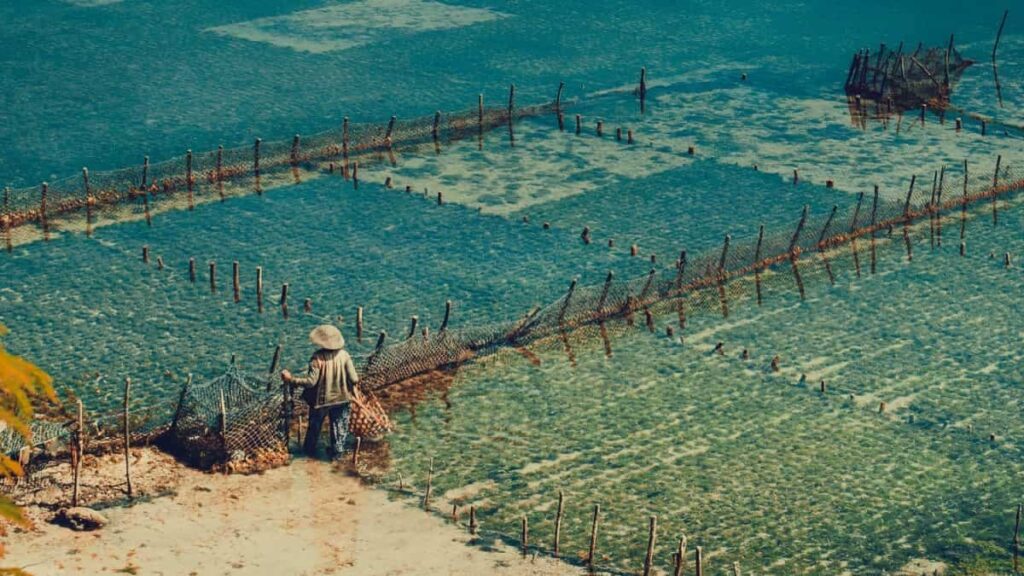
Seaweed Species Suitable for Farming in the Philippines
In the Philippines, various seaweed species are suitable for cultivation, with Eucheuma cottonii and Kappaphycus alvarezii being the most prevalent. Eucheuma cottonii, a red alga, thrives in intertidal zones’ shallow waters, while Kappaphycus alvarezii, a green alga, inhabits deeper waters. These species are favored for their ease of cultivation and high market demand. Additional options include Ulva lactuca, Enteromorpha flexuosa, Gracilaria edulis, and Sargassum spp. Each of these species boasts distinct growth rates and nutritional profiles.
Seaweed Cultivation Techniques in the Philippines
Seaweed cultivation in the Philippines requires precise techniques and essential equipment for successful and sustainable outcomes. To effectively nurture and harvest seaweed, specific tools are indispensable. These encompass dedicated harvesting instruments, a suitable boat for transportation, and designated nurseries or seed beds for seaweed growth. Alongside these, essential materials like seeds, plastic mesh, galvanized iron wire, and float lines are pivotal for a prosperous seaweed farming venture.
With these tools and resources, seaweed cultivation can yield abundant harvests while minimizing ecological repercussions. A nutrient-rich water source is paramount to facilitate optimal seaweed development. Accessibility to deeper waters is vital, ensuring farmers can conveniently access seaweed without intricate maneuvers. A location with minimal water movement is preferred to prevent the displacement of seaweed due to strong currents. Ample sunlight is essential for photosynthesis and growth.
Seaweed Farming Industry in the Philippines
Renowned for its socio-economic and ecological benefits, it revolves around cultivating various seaweed species, including Eucheuma cottonii and Kappaphycus alvarezii. These species are prized for their ease of cultivation, high market demand, and versatility in food and cosmetics applications.
The industry empowers coastal communities by providing livelihood opportunities and addressing environmental issues like illegal fishing. With proper techniques, equipment, and site selection, seaweed farming contributes to economic growth, sustains livelihoods, and promotes the environment.
Market Opportunities for Seaweed Farming in the Philippines
- Protocol Adherence: To ensure plant health, seaweed farms must adhere to established disease prevention and management protocols.
- Monitoring and Reporting: Monitoring disease incidence in the farm and nearby areas is crucial. Competent authorities should be informed of necessary remedial actions. Swift control measures are necessary for early disease manifestations.
- Outbreak Response: In the case of a potential disease outbreak, farming activities in affected areas must be promptly halted. Infected seaweeds should be disposed of under regulations, and competent authorities should be informed of appropriate intervention.
- Contaminated Seaweed Handling: Diseased or contaminated seaweed should be removed and disposed of properly. Such compromised seaweed should not be sold to prevent further spread.
In case you missed it: Eel Farming in the Philippines: A Profitable Eel Fish Business for Aqua Farmers
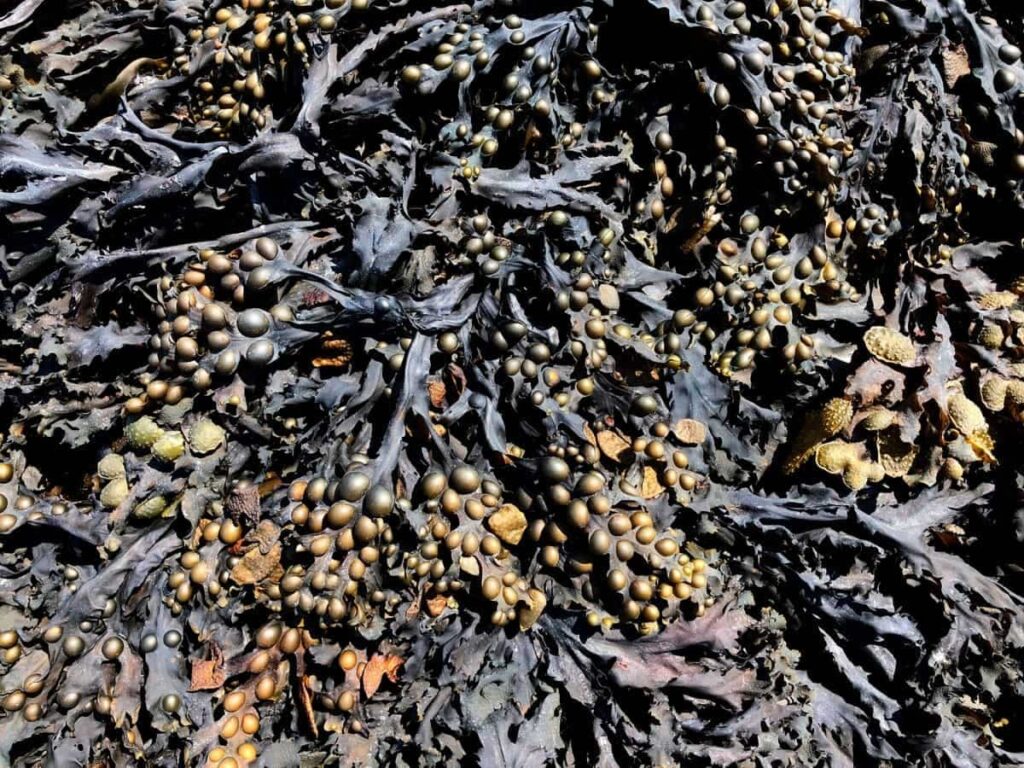
Harvesting and Transport of Seaweed
Harvest Timing: Seaweeds should be harvested after 45-60 days or when they reach the required maturity. For carrageenan processing, harvesting should occur after a minimum of 45 days of cultivation. The harvest timing should align with favorable weather and tidal conditions.
Harvest Practices: Proper harvesting procedures must be followed to maintain product quality. Harvested seaweed should be free from impurities, foreign materials, and non-biodegradable substances before and after drying.
Postharvest Handling and Transport Seaweed Farming in the Philippines
- Sanitary Handling: Postharvest structures, equipment, and tools should be cleaned and maintained in sanitary and operational conditions.
- Hygienic Operations: Washing, draining, drying, sorting, weighing, and packing operations should be executed hygienically to preserve product quality.
- Drying Procedures: Seaweeds intended for drying must follow correct procedures to meet existing product standards and retain unadulterated status.
- Proper Transport: Seaweed transportation should maintain product quality and consumer acceptability. Accompanying regulatory documents such as a health certificate, local transport permit, auxiliary invoice, or relevant regulatory paperwork issued by competent authorities are essential for transport.
Seaweed Farming Equipment and Technology in the Philippines
Specific equipment is vital for successful and sustainable seaweed farming in the Philippines. This comprises specialized harvesting tools, transport boats, nurseries or seed beds for seaweed growth, and essential materials like seeds, plastic mesh, galvanized iron wire, and float lines. By employing the right equipment and supplies, seaweed farming can yield.
Seaweed Farming Profitability in the Philippines
Melinda Gimotea, a resident of Balintang village in the southwestern of the Philippines’ Palawan province, finds profound joy in cultivating seaweeds. She describes how this activity brings her happiness and fosters communal bonds and family connections. Tying olive-green plant cuttings to ropes with floaters, she and her husband tend to their 2,500-square-meter seaweed farm, a routine they have followed for three decades.
People who are involved in the cultivation of Seaweed are earning a profit of 21,000 to 41,000 Philippine pesos (US$370 to US$723) a month or every production cycle.
In case you missed it: Koi Fish Farming in the Philippines: A Profitable Business
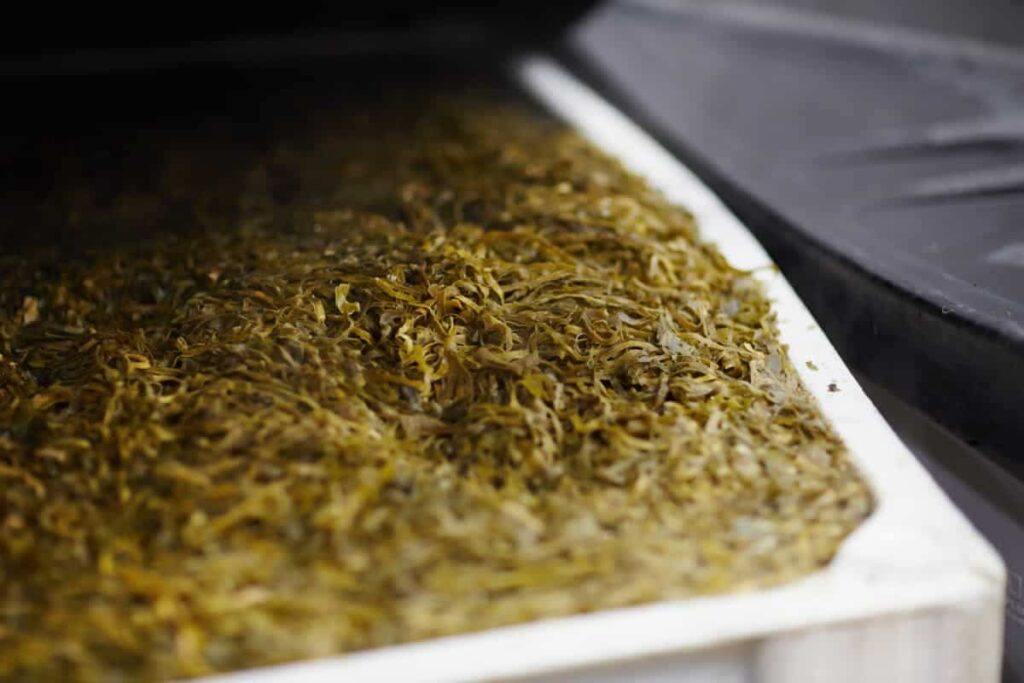
This practice has significantly impacted their livelihood, allowing them to financially support their family, educate their children, and access modern conveniences. The Philippines has evolved into the world’s fourth-largest aquatic plant producer, including seaweed, with over 200,000 coastal families participating in commercial seaweed farming. This practice addresses poverty and combats environmental issues like illegal fishing and habitat degradation.
Seaweed Diseases and Pest Management in the Philippines
Seaweed disease management in the Philippines entails strict adherence to established protocols. Farms must vigilantly monitor and report instances of disease in the farm and vicinity to competent authorities. Prompt reporting ensures swift remedial action and control measures when early signs appear.
In case of an impending massive outbreak, farming activities in affected areas must halt, and infected seaweeds must be properly disposed of following regulations. Timely notification to competent authorities is essential. Contaminated seaweed must be swiftly removed, properly disposed of, and not sold to prevent further dissemination and uphold product quality.
Climate Considerations for Seaweed Farming in the Philippines
Seaweed farming in the Philippines. The tropical climate, characterized by warm temperatures and ample sunlight, provides an ideal environment for seaweed growth. However, factors like typhoons and increased sea surface temperatures due to climate change pose challenges. Seaweed farmers must carefully time their operations to avoid extreme weather events and monitor water temperatures to prevent disease outbreaks.
Seaweed Processing and Value-added Products in the Philippines
- Seaweeds should be gathered within 45-60 days or upon reaching required maturity, especially for carrageenan processing, where a minimum of 45 days of cultivation is necessary.
- Timely harvests should align with favorable weather patterns and tidal conditions.
- Adhering to proper harvesting practices is crucial.
- Harvested seaweed must remain uncontaminated devoid of foreign and non-biodegradable materials before and after drying.
- Postharvest structures, equipment, and tools require regular cleaning and maintenance to ensure sanitary and effective operations.
- Washing, draining, drying, sorting, weighing, and packing procedures should be executed hygienically, preserving product quality.
- Seaweed designated for drying should undergo proper procedures to meet existing product standards and maintain unadulterated status.
- During transport, seaweed must remain uncompromised, accompanied by requisite documents like health certificates, local transport permits, and regulatory papers issued by competent authorities. Ensuring product quality remains unscathed during transport is imperative for consumer satisfaction.
Training and Education for Seaweed Farmers in the Philippines
These programs equip farmers with essential knowledge and skills, covering various aspects of seaweed cultivation, disease management, sustainable practices, and market trends. Farmers learn about proper techniques, innovative methods, and best practices through workshops, seminars, and hands-on training. This empowers them to make informed decisions, enhance productivity, and adapt to changing conditions. Well-trained farmers contribute to a thriving industry, better livelihoods, and environmental conservation, ensuring a prosperous future for seaweed farming in the Philippines.
In case you missed it: Profitable Carp Farming in the Philippines: A Step-by-Step Guide for Carp Fish Culture
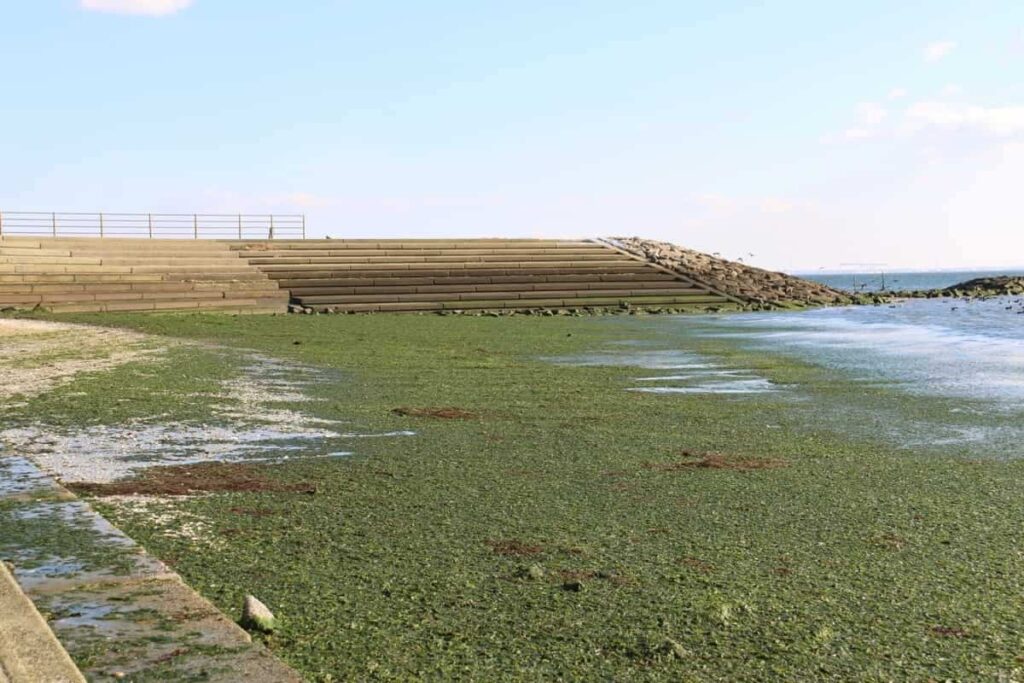
Personnel Health, Hygiene, and Training on the Safety of Seaweed Farming in the Philippines
- Individuals engaging in seaweed farming should be physically capable of performing the tasks.
- Workers must adhere to farm-level hygiene practices to prevent seaweed contamination.
- Those capable of contaminating products should not handle seaweed.
- Suitable clothing and protective gear are mandatory for workers.
- Hygienic practices should be maintained during postharvest work.
- Discrimination based on gender, race, religion, etc., is prohibited.
- Workers must be trained in safety procedures and first aid, with accessible first aid kits.
- Compensation should align with labor laws, working hours, and farming practices.
- Adequate, safe living conditions, including clean quarters, water supply, and toilets, are to be provided.
- Respect for local communities, particularly Indigenous Peoples and Cultural Communities, is vital, with adherence to laws governing land and resource use.
In case you missed it: Pangasius Farming in the Philippines: How to Culture Pangasius
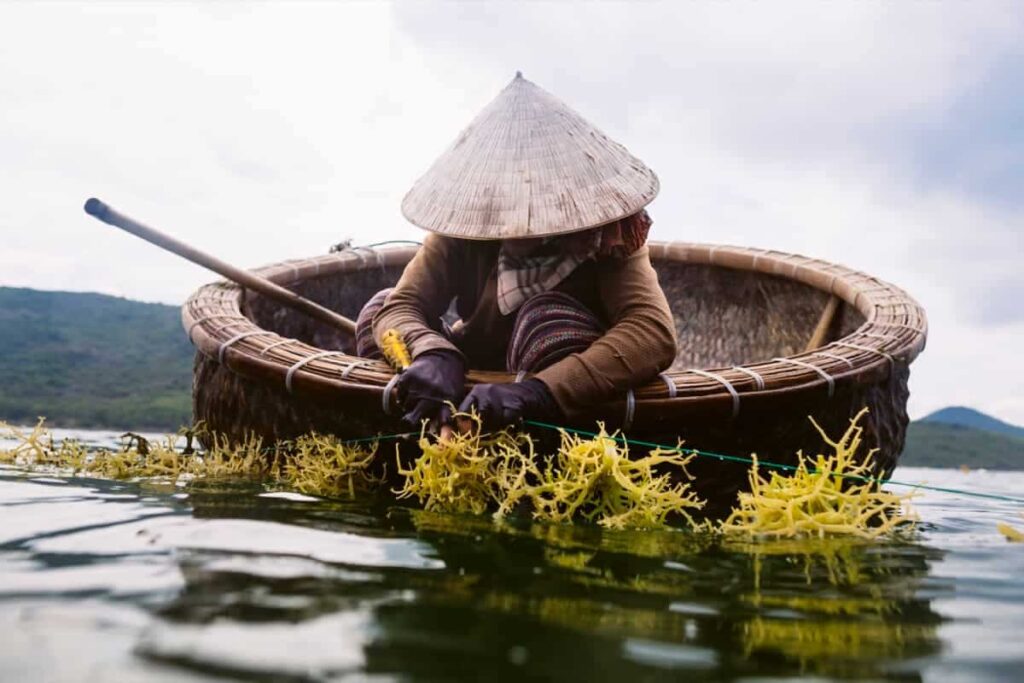
Conclusion
Seaweed farming in the Philippines embodies best practices through disease prevention, hygiene, and community engagement. Embracing sustainable techniques and continuous education empowers the industry to grow, securing livelihoods and ecological balance.
- How to Raise Pigs in Your Own Backyard: A Comprehensive Guide
- Budget Friendly Sheep Shed Ideas: Cheap and Low-Cost Tips
- How Much Do Cattle Farmers Make: Revenue Streams in Cattle Farming
- Management Pests and Diseases in Your Cotton Field
- Sheep Farming Business Plan for Beginners
- Aquaponic Farming at Home: A Step-By-Step Guide
- Profitable Village Farming Business Ideas in 2024
- High-Yield Aquaculture: Fast-Growing Fish for Farming
- Effective Fish Pond Construction Techniques for Beginners
- Irrigation and Water Management in Pineapple Farming
- Blossom to Harvest: Mastering Flowering and Pollination in Papaya Farming
- Pig Fattening Essentials: From Selection to Sale for Beginners
- Raising Wagyu Cattle: A Complete Guide for Premium Beef Production
- Soil Types and Their Water Holding Capacity
- Optimizing Irrigation Schedules for Coconut Groves for Enhanced Yield
- Espresso Your Garden: Coffee Grounds for Healthier Acid-Loving Plants
- The Best Soil Mix for Snake Plants: How to Mix Your Own Snake Plant Soil
- Green Thumb Success: Expert Tips for Cultivating Greenhouse Beans All Year Round
- Bloom All Year Round: The Ultimate Guide to Indoor Hyacinth Care
- Eco-Friendly Gardening: How to Make Liquid Fertilizer from Kitchen Waste
- Ultimate Guide to Grow Anise in Pots: Explore Seed Propagation to Harvesting
- Guide to Raising Chester White Pigs: Discover Breed Facts to Growth Management
- Mastering the Elegance: The Ultimate Guide to Weeping Cherry Tree Care, Planting, and Maintenance
- Ultimate Guide to Planting Garlic in Grow Bags: Growing Strategies for Beginners
- How to Fix Spider Plant Leaf-Related Problems: Natural and Organic Remedies
- 10 Reasons Why Your Tulsi Plant is Shedding Leaves: Home Remedies and Solutions
- Optimizing Growth and Yield: The Advantages of Palm Bunch Ash Fertilizer
- Utilizing Neem Oil Extract as a Natural Pesticide for Hydrangea
- From Soil to Harvest: Various Ways in Which Farmers Can Use AI Tools
- Steps to Encourage and Induce Citrus Flowers: A Comprehensive Guide
- How to Fix Snake Plant Leaf-Related Issues: Natural and Organic Remedies
- Transform Your Garden into a Fragrant Oasis with Raat Ki Rani (Night Blooming Jasmine)
- Discover the Ideal Chicken Breeds for Philippine Farms
- How to Create a Poultry Egg Farm Business Plan for Profits
- Grow Lemon Cucumbers Like a Pro: Insider Techniques for Bountiful Yields
- Ultimate Guide to Caring for Your Pink Princess Philodendron: Tips for Thriving Variegation
